Editor of this issue: Antanas V. Dundzila
Copyright © 1990 LITUANUS Foundation, Inc.

|
LITUANUS
LITHUANIAN QUARTERLY JOURNAL OF ARTS AND SCIENCES
Volume 36, No.2 - Summer 1990
Editor of this issue: Antanas V. Dundzila ISSN 0024-5089
Copyright © 1990 LITUANUS Foundation, Inc. |

|
CHRONOLOGY OF SEMINAL EVENTS PRECEEDING THE DECLARATION OF LITHUANIA'S INDEPENDENCE
June 3, 1988. At a meeting of intellectuals in Vilnius the Lithuanian citizens' movement, Sąjūdis, is formed, calling for greater political, economic, and cultural autonomy.
June 24, 1988. A rally of 50,000 demonstrate support for Sąjūdis, and demand that delegates to the 19th Communist Party Conference press for greater national autonomy.
July 3, 1988. The underground Lithuanian Freedom League publicly proclaims its political program calling for re-establishment of independence.
July 9, 1988. 100,000 gather in Vilnius' Vingis Park to meet with returning delegates from the 19th Communist Party Conference in Moscow. Lithuanian Communist Party Secretary announces the forthcoming legalization by Moscow of the banned flag of independent Lithuania.
August 5, 1988. Sąjūdis newsletter publishes the secret Molotov-Ribbentrop Pact and its protocols of August-September 1939.
August 23, 1988. Sąjūdis sponsors a demonstration of 200,000 to commemorate the loss of Lithuania's independence as a result of the above secret Pact.
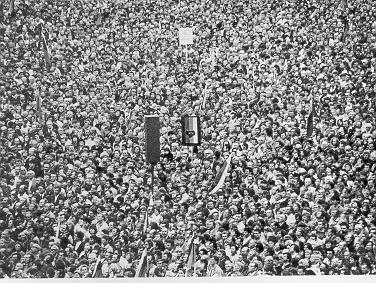
Demonstration organized by
Sajūdis in Vingis Park, Vilnius.
Photo by R. Urbakevičius
September 3, 1988. Tens of thousands form a human chain along the Baltic sea coast to protest its pollution.
September 16-17, 1988. Approximately 10,000 form a human chain around the Ignalina nuclear power plant demanding safety inspections by an international team of experts.
September 29, 1988. For the first time representatives of Sajūdis and the Lithuanian Freedom League share the same platform at a rally of 5,000 to protest militia violence against peaceful demonstrators and hunger strikers.
October 7, 1988. 100,000 gather in Vilnius to witness the raising of the now legal Lithuanian national flag over the tower of the historic medieval castle on Gediminas hill.
October 20, 1988. Algirdas Brazauskas becomes head of the Lithuanian Communist Party, promising major reforms, including multi-candidate elections and better church-state relations.
October 22-23, 1988. Sąjūdis holds its founding Congress in Vilnius, attended by more than 1,100 delegates, and elects a 220-member national assembly and an executive council of 35. Professor Vytautas Landsbergis is elected to head Sajūdis. Proceedings are broadcast live on TV, including an address by Antanas Terleckas, leader of the Lithuanian Freedom League, calling for immediate restoration of Lithuania's independence. The government announces the imminent return to the faithful of the historic Vilnius cathedral which has been turned into an art museum 48 years ago. The following day the recently annointed Cardinal Vincentas Sladkevičius celebrates mass outside the Cathedral with tens of thousands of worshippers in attendance.
November 1, 1988. For the first time, the Soviet regime accords recognition of a religious feast day—All Saints Day.
November 9, 1988. Sąjūdis launches a massive drive to petition the Supreme Soviet against proposed changes to the Soviet Constitution which would centralize power in Moscow to an even greater extent than heretofore.
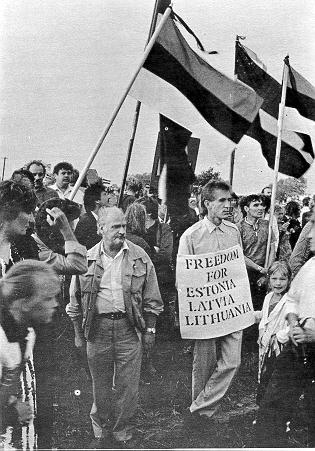
Baltic crowds waiting to link arms at the Lithuanian-Latvian border on August 23. 1990.
Photo K. Sverys
November 11-14, 1988. Politburo member Nikolai Slyunkov visits Lithuania-while two others travel to Estonia and Latvia— in an apparent attempt to counter demands by the Baltic republics for greater local self-rule. Lithuanians are angered by his reference to Lithuania as a "territory."
November 17-18, 1988. The Lithuanian Supreme Soviet, convening one day after the Estonian Supreme Soviet declared its sovereignty, is prevented by the Lithuanian Communist Party from voting on a similar resolution. The move brings forth angry protests by Sqjūdis and is the onset of tension between it and the local party leadership.
November 20, 1988. Sąjūdis declares the "moral independence" of Lithuania, and that "henceforth only those laws will be honored which do not limit Lithuania's independence."
November 21, 1988. 10,000 gather in Vilnius' Gediminas square in a show of solidarity with Sąjūdis, and to demonstrate against the Lithuanian Communist Party's decision to block to vote on sovereignty.
November 24, 1988. Sqjūdis presents to the Supreme Soviet in Moscow petitions signed by 1,8 million residents of Lithuania (one-half of the entire population) to protest changes in the Soviet Constitution which would further centralize power in Moscow.
November 26, 1988. The two major Lithuanian national democratic movements stage separate rallies in Gediminas square in Vilnius. The first, organized by Sąjūdis (attended by approximately 20,000) urges Lithuanian deputies departing for the All-Union Supreme Soviet session in Moscow to defend Lithuania's right to sovereignty. The second, organized by the Lithuanian Freedom League (attended also by approximately 20,000) denounces proposed changes in the Soviet Constitution, opposes sovereignty as a half-measure, and demands the withdrawal of Soviet forces from Lithuania.
December 29, 1988. Bishop Julijonas Steponavičius, exiled from his Vilnius diocese in 1961 for refusing to condone government interference in church matters, is notified that his 48-year banishment is over, and that he can resume his pastoral duties in Vilnius.
January 10, 1989. 50,000 demonstrate in Vilnius demanding independence and withdrawal of the Red Army. The rally, sanctioned by the local government, is sponsored by the Lithuanian Freedom League and the nascent Lithuanian Democratic Party to mark the last German-Soviet secret protocol on the disposition of Lithuanian territory. The rally approves a resolution to the United Nations' Decolonization Committee requesting it to place on its agenda for the U.N. General Assembly, the question of terminating the colonization of the Baltic states.
January 15,1989. Four Sąjūdis candidates win seats in the Lithuanian Supreme Soviet.
January 24, 1989. Sąjūdis announces the candidacy of its members for all 42 seats alloted to Lithuania in the All-Union Congress of People's Deputies.
January 25, 1989. The Presidium of the Lithuanian Supreme decrees the implementation of Lithuanian as the official language in administration, public services, and in all laws and legislative acts. Senior government officials and managers are allowed two years to learn the language. A second decree declares February 15th, the anniversary of the Lithuanian declaration of independence in 1918, a republic holiday.
February 6-7, 1989. Five members of the European 'Parliament meet in Vilnius with supporters of the Lithuanian Freedom League and other pro-independence groups which express concern that the parliamentarians favor only limited autonomy for Lithuania. Sąjūdis leadership presents a statement emphasizing that Lithuanians will accept nothing less than political independence.
February 14, 1989. The Russian "Jedinstvo" organizes a rally of 50,000 non-Lithuanians to protest the law implementing Lithuanian as the official language. It also calls for replacement of the Lithuanian Communist Party leadership and urges a work stoppage to protest the decision to re-establish Lithuanian Independence Day as a republic holiday.
February 15-16, 1989. 200,000 participate in the Sąjūdis sponsored two-day commemoration of Lithuania's independence in Kaunas and Vilnius, which includes re-dedication of the Lithuanian Freedom Monument removed by the Soviet occupiers. The national assembly of Sąjūdis in Kaunas—in its most radical statement to date—calls for re-establishment of an independent, democratic and neutral Lithuanian state.
February 21, 1989. At the Lithuanian Communist Party plenum officials angrily denounce Sąjūdis' support for political independence and accuse it of deviating from its original intent to support "perestroika." Party Secretary Brazauskas threatens to tighten restrictions on independent press, as well as on party members who are active in the leadership of Sąjūdis. Broadcast of Sąjūdis' 90-minute weekly TV program is suspended. (It is re-instated on April 12, 1989.)
February 24, 1989. 8,000 participate in a pacifist demonstration in Kaunas and call for a stop to the forced induction of Lithuanians into the Red Army.
February 28, 1989. Sąjūdis candidates—challenging the Lithuanian Communist Party's first and second secretaries Brazauskas and Vladimir Berezov in the March 26 election to the Congress of People's Deputies—withdraw at the behest of Sąjūdis' Executive Council who hypothesized that the expected victory over two party leaders would cause Moscow to replace them with officials hostile to the Lithuanian national democratic movement.
March 26, 1989. Sąjūdis wins a stunning 31-member victory to the USSR Congress of People's Deputies, a clear manifestation of Lithuanian people's support for the movement for independence, while rejecting the communist ideology and Soviet colonialism.
April 1, 1989. At the 4th session of Sąjūdis its President Vytautas Landsbergis, states that Lithuania is evolving toward a multi-party system which includes the Lithuanian Freedom League, the Greens, and the emerging Lithuanian Christian Democratic Party, the Lithuanian Democratic Party, the Workers' Party, and the Lithuanian Social Democratic Party.
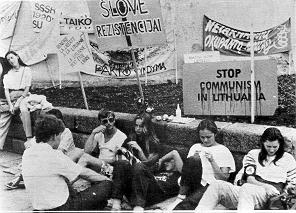
Lithuanians demonstrate for their independence.
Photo by V. Kapočius
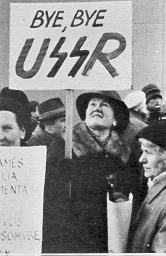
Lithuanians rejoice over their newfound independence - Vilnius, March 11, 1990.
Photo by Ė. Šulaitis.
May 13-14, 1989. The first joint assembly of representatives from the independence movements in the three Baltic republics is held in Tallinn, Estonia. Approximately 500 leaders participate from the Lithuanian Sąjūdis, and the Popular Fronts of Latvia and Estonia respectively, calling for independence in a neutral and demilitarized zone comprised of the three republics.
May 18, 1989. The Lithuanian Supreme Soviet (by a vote of 291 to 8 and 3 abstaining) declares for self-determination and restoration of state sovereignty.
May 26, 1989. At the Soviet Congress of People's Deputies Vytautas Landsbergis, the head of Sąjūdis, threatens to boycott elections in protest of the violation of sovereignty rights of respective republics. The protest is withdrawn and a crisis averted.
May 31, 1989. At the above Congress the Lithuanian Communist Party head demands that the Kremlin reveal "the historic truth" about the Molotov-Ribbentrop Pact. A commission to investigate it is set up.
July 1, 1989. Soviet President, Mikhail Gorbachev, tells viewers of Moscow TV that the Baltic national drive for independence would not be tolerated.
July 7, 1989. While in New York, Vytautas Landsbergis, head of Sąjūdis, responds to Gorbachev's above statement of July 1: "Our right to self-determination is ours, and we don't have to beg anyone for it . . . Some great leaders believe that they can bestow these rights and take them away. This is an antiquated mentality of the times of serfdom." (at a reception at N.Y.' Freedom House.)
July 12, 1989. 10,000 gather at Lenin's Monument in Vilnius to mark the Lithuanian-Soviet Peace Treaty of 1920, under which Lenin's government renounced all claims to Lithuania's territory.
July 27,1989. The Supreme Soviet endorses a plan to give the Baltic republics an unprecedented degree of economic independence beginning next year. The three republics would control their own trade, industry and resources, and a right to conduct their economies on a free-market basis.
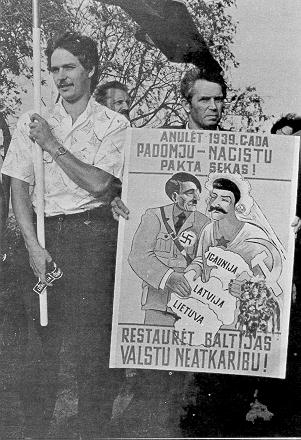
Marching to the demonstration on August 23, 1989 near the Lithuanian-Latvian border.
Photo K. Sverys
August 22, 1989. Fourteen of the twenty-six members of the USSR Supreme Soviet Commission to investigate the Molotov-Ribbentrop Pact of 1939 and its secret protocols, report that they should be annulled, and that relations between the Baltic States and the Soviet Union should be governed by the 1920 treaties under which the USSR guaranteed the territorial integrity of the three Baltic states.
August 23, 1989. More than one million people stage a human chain demonstration across the three Baltic republics protesting the 1939 Stalin-Hitler pact that led to the loss of their respective independence.
August 26, 1989. The Central Committee of the Soviet Communist Party issues a statement accusing the independence movements of Lithuania, Latvia, and Estonia of exploiting the atmosphere of Soviet reform to "disintegrate the cohesion" of the Soviet Union, and warns of "impending disaster."
September 1, 1989. Despite quasi threats from the Kremlin, the leaders of the political national movements in the three Baltic republics—using moral pressure and serene defiance—state that they have prepared a new, more radical platform, demanding special status for the region in its transition to complete independence.
September 15, 1989. President Gorbachev meets with leaders of the three Baltic republics to discuss a compromise to avert the growing demands for secession.
November 16, 1989. Lithuanian Communist Party leaders inform the Soviet Politburo that despite its warnings, they plan to become autonomous of Moscow.
December 7, 1989. The Lithuanian Supreme Soviet repeals Article 6 of the constitution (which gave the Communist Party dominance) and legalizes a multi-party system.
December 20, 1989. The Lithuanian Communist Party votes overwhelmingly to become independent of Moscow.
December 22, 1989. The Baltic delegate at the Soviet Congress of People's Deputies reject a Moscow proposal to establish a committee of constitutional supervision, claiming it would infringe on their respective rights.
December 24, 1989. The above Congress adopts a tepid resolution admitting that the Soviet-German Pacts of 1939 violated "the sovereignty and independence of other nations and were legally untenable and invalid from the moment they were signed."
December 25, 1989. Speaking to the Central Committee of the Soviet Union's Communist Party, M. Gorbachev denounces as "illegitimate" the Lithuanian Communist Party's decision to become autonomous, and warns that the Soviet Union would not permit "the breakup of the federal state."
January 4, 1990. M. Gorbachev meets with Lithuanian Communist Party leaders and leans toward a compromise on the split. He plans a three-day visit to Lithuania.
January 10, 1990. Tens of thousands rally in Vilnius in support of total independence on the eve of Gorbachev's visit, despite a request by Kremlin's ideology chief Vadim Medvedev to cancel it.
January 11, 1990. On his visit to Lithuania, Gorbachev appeals to Lithuanians not to press for independence and promises that the Supreme Soviet will consider laws for secession, as well as more decentralization and more democratization.
January 12, 1990. Leaders of Sąjūdis denounce as "a cheap lie and propaganda" Gorbachev's announcement that the Kremlin has begun work on a draft law outlining procedures for the republics to secede. Vytautas Landsbergis calls it an insult, that the people must decide for themselves, and that accepting such a law would indicate being a legal part of the Soviet Union to begin with.
January 13, 1990. Gorbachev expresses willingness to accept a multi-party system in the Soviet Union, and seems to have failed in his attempt to persuade the Lithuanian
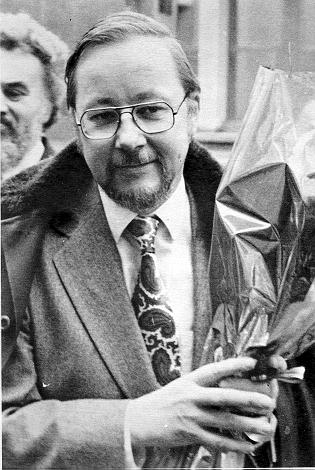
Vytautas Landsbergis in Vilnius on March 11, 1990.
Photo by E. Šulaitis
Communist Party to end their split with Moscow, or to temper demands for total independence.
January 15, 1990. In a vote of 228 to 4 (19 abstaining) Lithuanian Communist Party head, Algirdas Brazauskas, is elected by the Lithuanian Supreme Soviet as President of the republic, in seeming endorsement of his defiance of Moscow and Gorbachev.
February 24-March 4, 1990. In a multi-party election Sąjūdis endorses and wins a sweeping majority in the Lithuanian Parliament.
March 11,1990. Vytautas Landsbergis, the head of Sąjūdis is elected President of Lithuania by a vote of 91 over Brazauskas' 38 votes. By an overwhelming vote of 124 (6 abstentions), the parliament declares the restoration of Lithuania's independence.
Compiled by Danutė S. Harmon
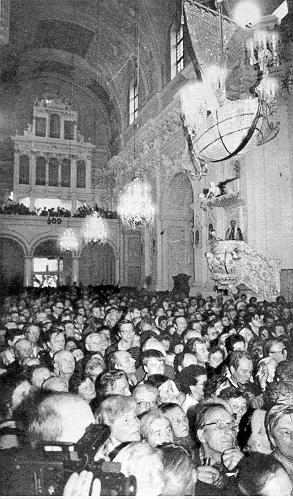
Lithuanians thank the Lord for their independence—Vilnius, 1990.
Photo by E. Šulaitis
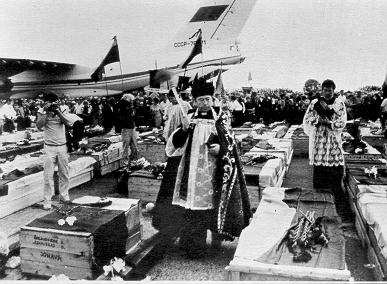
Remains of Siberian exiles returned to Lithuania—Kedainiai, 1989.
Photo by V. Kapočius